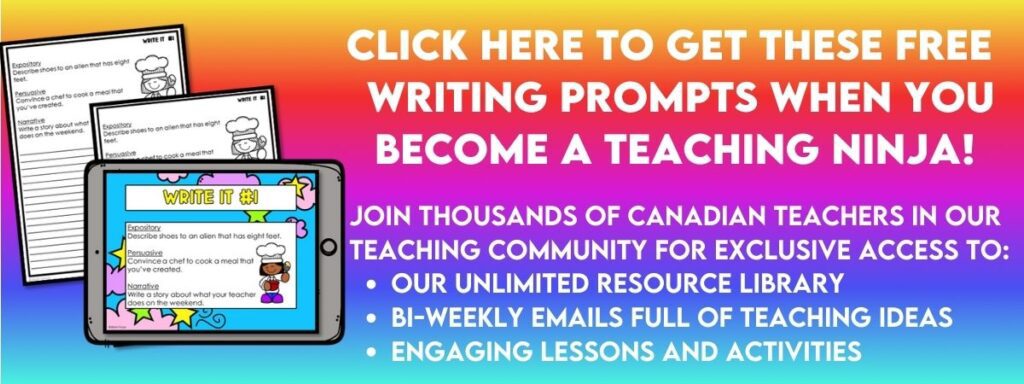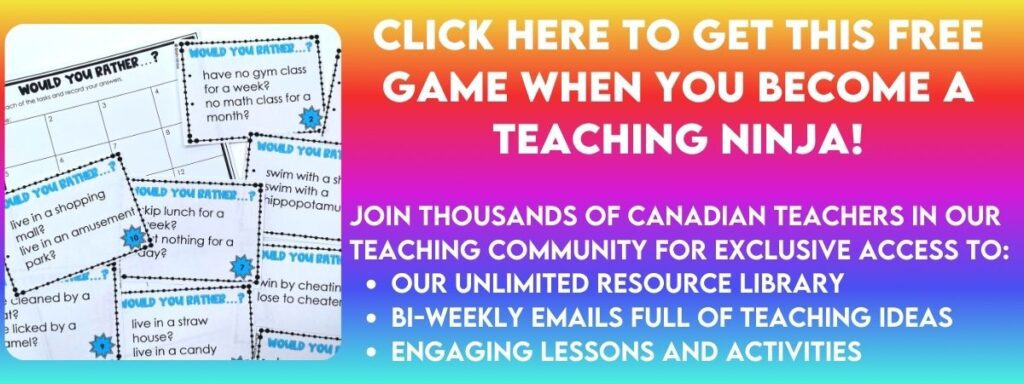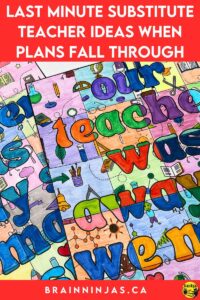
Have you been hired as a substitute teacher at the last minute? Are there no substitute teacher plans in place or you can’t find them? We pulled together this list of activities you can use to get your day sorted out. Most of the activities are designed for upper elementary, but you might be able to adapt them for your group of students.
Being a substitute teacher often means being prepared to step into any classroom situation with little notice. Having a repertoire of engaging and easy-to-implement activities is essential. We’ve been in your shoes, from both sides. If you’re a teacher looking for a way to organize your emergency sub plans, we recommend this post to get you started: It’s Time to Get Your Emergency Sub Plans Ready.
If you’re a substitute teacher, we recommend putting together a bag of “last minute tools.” Make a few copies, have a few books and keep a few activities ready to use so that they can be used the second you show up in a classroom. You can replace your copies later in the day. That way you’re prepared for the next job.
Most teachers leave plans for their substitute teachers and really prefer if you stick to those plans. Those plans can take hours to prepare so it can be very frustrating to come back and learn all that time and preparation is wasted.
However, sometimes teachers need to be away unexpectedly. Most schools require teachers to leave emergency plans. But, in our experience, the office staff is not always good at communicating this to substitute teachers. Sometimes it takes time to find the plans, so you might need to cover part of the class without any plans or schedules.
Plan Simple Activities That Can Work Almost Anywhere
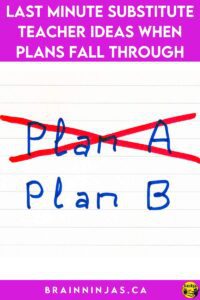
It is important to have a few activities that your students can do independently. This gives you a bit of time to organize materials, log in to the school system, get attendance done and just get your bearings.
You’ll also need activities to fill time in case planned activities fall through, take less time than planned or you just need a bit of extra time to get things in order. These activities are fairly easy and generally require students to have writing tools or colouring gear, but you may need to make a few copies or project something on a screen.
Silent Reading Time
Encourage students to take out a book of their choice and engage in silent reading. This not only promotes literacy but also provides a calm and focused atmosphere for students to unwind and enjoy literature. It does not matter what students are reading as long as they are sitting quietly with a book. Try to limit this to no more than ten minutes while you get the first activity of the day ready.
Writing Prompts
Provide students with writing prompts or creative writing exercises to spark their imaginations. Topics could include writing a short story, composing a poem, or journaling about their day. This only requires a piece of a paper and pencil to get started.
If you’re looking for ready-to-use writing prompts, we have this free set in our Resource Library. We can even send it directly to your inbox when you sign up for our email list.
Brain Teasers and Riddles
Challenge students with brain teasers, riddles, or logic puzzles to stimulate critical thinking skills and problem-solving abilities. Websites like Riddles.com offer age-appropriate puzzles. It has a riddle of the day and a math problem. This is pretty quick, but it can give you a few minutes between transitions or at the end of the day. There are also lots of joke or riddle books that you can find. Keep one in your bag.
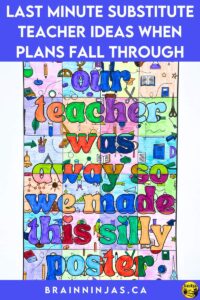
Collaborative Posters
Students each colour a page and the pages are put together in one poster. Our sets come with 18, 24 or 36 pieces so they work with nearly any size class. We even include an activity to use with early finishers. This set is designed for substitute teachers. Find the Substitute Teacher Collaborative Poster in our TpT Store ($USD) or our BN Shop ($CAN). We have lots of other themed posters for specific times of year year, too. Learn more about collaborative tasks in this post: How to Use Collaborative Tasks to Create Classroom Community.
Classroom Scavenger Hunt
Create a list of items or clues for a classroom scavenger hunt. Instead of a list where students can have to find items, they could count the items.
This is a list of items you can include: desks, chairs, whiteboard or chalkboard, markers or chalk, erasers, screens, curtains for windows, books (textbooks, novels, reference books, etc.), pens, pencils, notebooks, rulers, scissors, glue sticks or liquid glue, staplers, hole punches, tape dispensers, paper clips, calculators, clocks or timers, waste bin or trash can, maps, computers or laptops, printers or photocopiers, bulletin boards, shoes, students or anything else you can think of. You could even have a space for students to add their own items.
Role-Playing Activities
Encourage students to engage in role-playing activities where they take on different characters or scenarios. This can help develop communication skills, empathy, and creativity. Make a list of careers that students can act out.
Classroom Discussions
Facilitate classroom discussions on topics of interest or current events. Encourage students to express their opinions, ask questions, and engage in respectful dialogue with their peers.
If you’re stuck on a topic, ask students to explain school procedures, rules or routines.
Physical Activities
Engage students in physical activities or brain breaks to energize their bodies and minds. Activities could include yoga poses, stretching exercises, or quick dance breaks.
If you can take students outside for a breath of fresh air, go outside. You can read, play a game, study something (like clouds or plants) or draw something you see. Ask them to observe and document what they see, hear, smell, and feel. Upon returning to the classroom, discuss their observations and encourage them to write or draw about their experience.
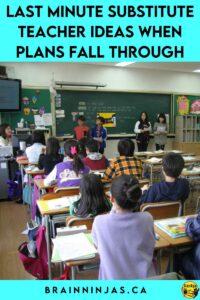
Journaling
Provide students with writing prompts or journaling topics to reflect on their thoughts, feelings, and experiences. Journaling can help students develop self-awareness and emotional intelligence.
They can tell their teacher how the day has gone or something that is on their mind.
Charades
Organize a game of charades or drawing pictures of words to promote communication skills, creativity, and teamwork. Students can take turns acting out words or phrases or drawing clues for their classmates to guess.
Pre-Made Sub Plans
We created these sub plan sets for teachers to leave as their emergency sub plans. Substitute teachers can use them in their bag of goodies. Our sets are designed for Canadian classrooms and use Canadian themes, spellings and measurements.
Video Games Emergency Sub Plans Grades 3-4 This set is about video games and related occupations. You can find it in our TpT Store ($USD) or our BN Shop ($CAN).
Hoaxes and Ogopogos Emergency Sub Plans Grades 4-6. This is all about water creatures and hoaxes. Find it in our TpT Store ($USD) or our BN Shop ($CAN).
Sticky Situations Emergency Sub Plans Grades 4-6 This set is all about maple syrup, molasses, and honey. It’s Canadian-themed for Canadian classrooms. It’s available in our TpT Store($USD) or in BN Shop ($CAN).
Ships and Wrecks Emergency Sub Plans Grades 4-6 This set is about the RMS Titanic and the Bluenose as well as sunken ships around Canada. You can find it in our TpT Store ($USD) or our BN Shop ($CAN).
If you teach French as a Second Language, we created this set of French Class Emergency Sub Plans Emergency Sub Plans Grades 4-6. They are designed with English plans so it doesn’t matter who covers your French class. These are not meant for French Immersion. You can find them in our TpT Store ($USD) or our BN Shop ($CAN).
20 Questions
Challenge students to play “20 Questions,” where they must guess an object, animal, or person by asking yes or no questions. This game promotes critical thinking and deductive reasoning skills.
Word Chain
Begin a word chain by writing a word on the board (e.g., “dog”). Then, have students take turns saying words that start with the last letter of the previous word (e.g., “dog,” “goat,” “turtle”). It’s a simple yet engaging way to practice vocabulary and thinking on the spot.
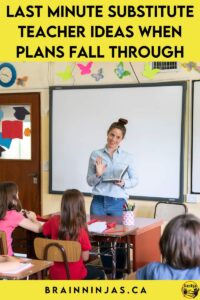
Freeze Dance
Play some music and have students dance around the room. When the music stops, they must freeze in place. It’s a fun and energetic activity that allows students to let loose and burn off some energy.
Name That Tune
Hum or play short snippets of popular songs and see if students can guess the song title or artist. This activity is entertaining and helps develop listening skills and musical knowledge. Use simple songs like “Happy Birthday” or “O Canada.”
Brainstorming Sessions
Initiate brainstorming sessions on various topics, such as “What are some inventions that could make the world a better place?” or “What superpower would you choose and why?” Encourage students to share their ideas and reasoning.
We have a set of questions that are ideal for this activity. Find the Would You Rather…? Game in our Resource Library. We can even send it directly to your inbox when you sign up for our email list.
DIY Origami
Teach students how to make simple origami creations like paper airplanes, fortune tellers, or jumping frogs. Origami only requires paper, and it’s a great way to foster fine motor skills and creativity.
This is a fun and fairly easy activity with instructions. It is found on YouTube. Be sure to monitor it for ads and volume levels.
Mad Libs
Provide students with Mad Libs worksheets or create your own by prompting them to fill in the blanks with nouns, verbs, adjectives, etc. Then, read the completed stories aloud for some laughs. You can find these at most bookstores. Use sticky notes on the blanks to be able to reuse them.
Tell Us Your Stories
We’d love to hear your best advice for substitute teachers or your stories on the job. Leave us a comment below.

